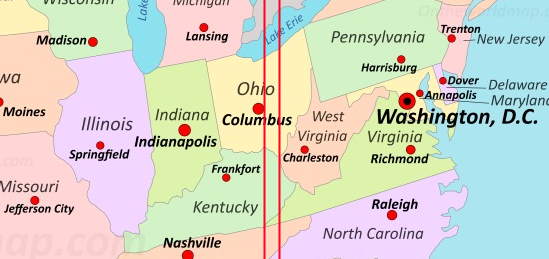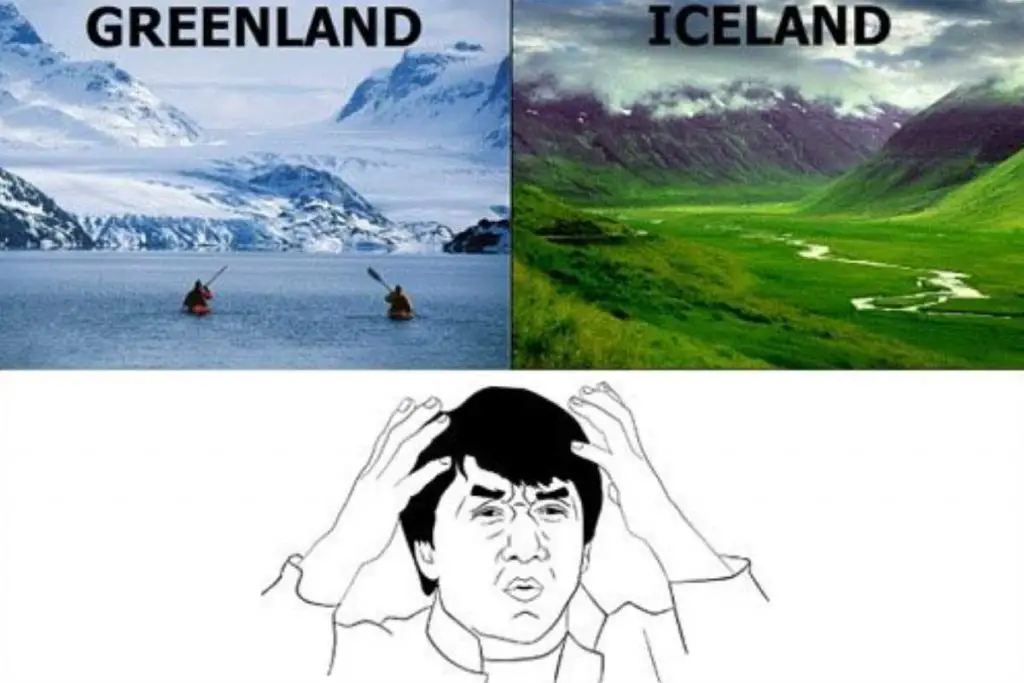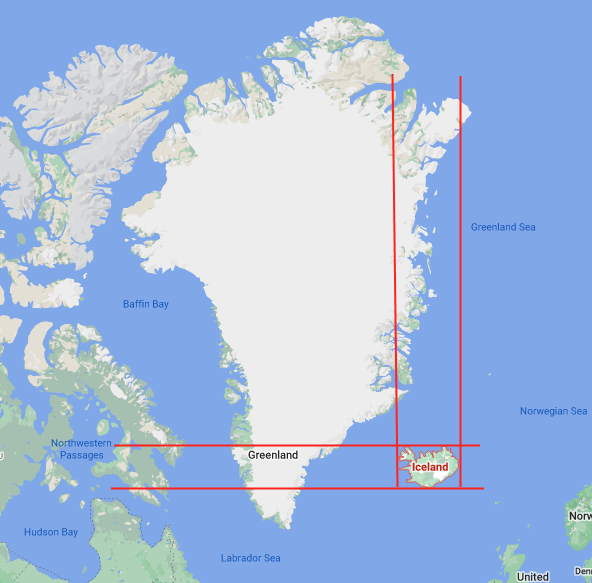Earth is an amazing place. Not only it is a beautiful oasis in the vast, cold space, it also has many interesting and even strange features. Here are 10 fun geography facts.
Fun Geography facts
1. Greenland is farther north, south, east, and west than Iceland.
Just look at the map below.
Greenland vs Iceland coordinates:
- The northernmost point of Greenland: Kaffeklubben Island (83°40’N) – it is also the northernmost permanent land in the world. There are also some shifting gravel bars that lie north of Kaffeklubben, the most famous being Oodaaq.
- The northernmost point of Iceland: Kolbeinsey, Eyjafjörður (67°08′N)
- The southernmost point of Greenland: unnamed islet 2.3 km south of Cape Farewell, Egger Island (59°44’N)
- The southernmost point of Iceland: Surtsey, Vestmannaeyjar (63°17′N)
- The westernmost point of Greenland: Nordvestø, Carey Islands (73°10’W)
- The westernmost point of Iceland: Bjargtangar, Vestur-Barðastrandarsýsla (24°32′W)
- The easternmost point of Greenland – Nordostrundingen, Greenland (11°19’W)
- The easternmost point of Iceland: Hvalbakur, Suður-Múlasýsla (13°14′W)
2. The northernmost point of Ireland is not in Northern Ireland
It is in the borders of the Republic of Ireland: the northernmost point of Ireland is Banba’s Crown (the tip of Malin Head), Inishowen Peninsula, County Donegal, Republic of Ireland (Latitude: 55° 23′ 4″ N).
3. Virginia extends farther west than West Virginia

- The westernmost point of West Virginia: 82.68°W
- The westernmost point of Virginia: 83.68°W
4. Africa is the only continent that covers four hemispheres
The Equator and The Prime Meridian describe the four hemispheres of the earth. The Equator is halfway between the North and South Poles; the meridian that intersects Greenwich, England is the Prime Meridian. Unlike the equator, the prime meridian is ultimately arbitrary.
Four continents are situated in two hemisphere zones: South America and Asia cover the northern and southern hemispheres, and Europe and Antarctica cover the western and eastern hemispheres. But, only Africa covers the northern, southern, eastern, and western hemispheres.

5. The Pacific entrance of the Panama Canal is farther East than the Atlantic entrance
Another fun geographical fact about the coordinates: the Pacific entrance of the Panama Canal is farther East than the Atlantic entrance.
- The coordinates of the Pacific entrance of the Panama Canal: 8.88846°N 79.52145°W
- The coordinates of the Atlantic entrance of the Panama Canal: 9.38743°N 79.91863°W
6. The westernmost point of China is closer to Germany than it is to the easternmost point of China.
The same is also true for Russia but it’s too obvious.

7. New York City is farther south than Rome
Yes, that’s true. New York City sits at 40.7128° North, while Rome is at 41.9028° North.

8. More people live inside that small circle in Asia than outside of it
That small circle in Asia contains more than half the world’s population.

9. In the Philippines, there’s an island that’s within a lake, on an island that’s within a lake, on an island.
Can you imagine an island within a lake that is situated on an island located in a lake on an island? Confused? Well, it is really confusing, but this island does indeed exist: Vulcan Points is the world’s largest island within a lake (Crater Lake) that is situated on an island (Taal Volcano Island) located in a lake (Lake Taal) within an island (Luzon).

10. Yesterday and Tomorrow Islands
Despite being just 2.4 miles (3.8 kilometers) apart, the Diomede Islands (Big Diomede of Russia and the Little Diomede of the United States) have a 21-hour time difference between them. That’s why they are nicknamed Yesterday and Tomorrow Islands.
This significant gap in time is due to the International Date Line passing between the two islands.

Bonus fun geography fact: Iceland is greener than Greenland

Sources
- Geography of Greenland on Wikipedia
- List of extreme points of Iceland on Wikipedia
- Yesterday and Tomorrow Islands on the NASA website
- Moon Landings: All-Time List [1966-2025] - February 2, 2025
- What Is Max-Q and Why Is It Important During Rocket Launches? - January 16, 2025
- Top 10 Tallest Rockets Ever Launched [2025 Update] - January 16, 2025



